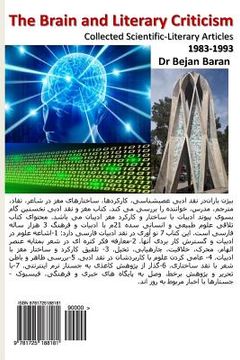Reseña del libro "Brain and Literary Criticism"
Brain and Literary Criticism is a collection of 60 articles in Farsi written from 1983 to 1993 and published on the Iranian Literary sites. The book is in 480 pages with 20 Figures on the brain and poetry. It is the first step to dissect poems using 100 functions of the brain such as imagination, creativity, logic, language, and memory. There are specific poets or poems to demonstrate the brain functionalities. The random thoughts are used to explain inspiration and problem solving. Some of the literary tropes are analyzed in a Persian poem, using Lacan's metaphor in the selection of one word for another and metonymy in the combination for word-to-word connection. The 2-axis of Saussure semiotics is also used in the Iranian New poems dissections. The 5000 years of Iranian culture with literature and Persian rugs are correlated through a pattern of repetitive design or rhythm. The history of Iranian poetry is surveyed from Zarathustra Gathas, Omar Khayyam Rubaiyat, and New Poetry, to contemporary and Post-Modernism. The Iranian literary genres and schools are surveyed too. Aesthetics of Kant and Schopenhauer applied in Iranian poetry are categorized under 12 techniques with illustrative poems. They are hierarchy, focus, contrast, tension, balance, flow, depth, scale, motion, rhythm, unity, and symmetry. The contemporary 20 literary theories are applied to Persian poetry. The literary principles are applied to Persian poetry. Art appreciation is discussed in terms of brain hormone changes. A poem analysis flow chart follows as: Is this poem appealing? If no, then admit that to yourself and stop being disingenuous with the poet and the readers. If yes, then: Is this poem socially important enough to you, at face value to or principle, using the 6 elements of poem chart to analyze it even when you know it bothers the readers? Yes/ No. If no, then you stop talking on the poem outside casual mentioning and, for your own peace of mind, own it as your choice to do so. Do not pass it off as something the reader "made you" do. If yes, then state clearly to your reader once more, transparently and in full, that this poem has merit to you feel entitled to enjoy as you would any piece of arts. Then see how your reader responds to this implied choice, to either accept you and your analysis of the poem or not accept you and discard the analysis. If the reader tries again to have it both ways, to accept you but not reject the analysis, then you reject the reader. The emotional math is straight- forward. But there is a reason that it is about courage. It is hard to stand openly for who you are and what it might cost you a reader you value. The reader's snark and your lies are not right or healthy or fair, but they are human. It is the rare analyst who has not defaulted to one or both in attempts to minimize the emotional exposure and therefore risk. It is the history ultimately sorts out the poem as a piece to be read or discarded. ** Bejan Baran is an Iranian-American poet and critic. He has published 4 books of poetry and literary criticism in English and Persian; with 2 more readied for publication: 4Seasons and The Rain's Journey. His poems and articles on poetic processes are published in World Literature Today and Iranian Web sites. He has translated into English, Iranian New poems by Nima Yushij (1895-1958), Ahmad Shamlu (1925-2000), Mehdi Akhavan (1928-1990), Forough Farrokhzad (1935-1967). In literary criticism, he discards the traditional periodization of Iranian literature on the basis of monarchical dynasties; opts for literary styles to anchor poets or poems in history. He thinks: Poetry is the capture of the transient moment in an eternal expression for education, pleasure, and history. As Hafez of 14th century said, poetry is the "recording in the World's chronicle;" a moment that repeats itself whenever a reader looks at the poem.

